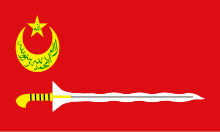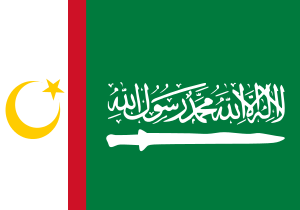Bangsamoro Autonomous Region
| Bangsamoro | |
|---|---|
| Autonomous region | |
| Bangsamoro Autonomous Region in Muslim Mindanao | |
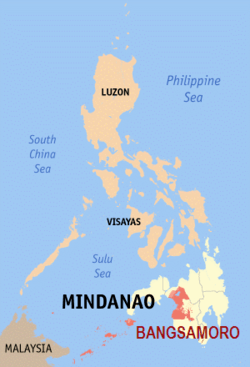 Political map of the Bangsamoro Autonomous Region | |
| Country |
|
| Projected establishment | Upon the ratification of the Basic Law on selected areas in Muslim Mindanao |
| Government | |
| • Type | Devolved regional parliamentary government within a unitary constitutional republic |
| • Wāli | To be selected |
| • Chief Minister | To be elected |
| • Deputy Chief Minister | To be elected |
| • Speaker of the Bangsamoro Parliament | To be elected |
| Demonym(s) | Bangsamoro |
| Time zone | UTC+8 (PST) |
The Bangsamoro Autonomous Region (Filipino: Rehiyong Awtonomo ng Bangsamoro Arabic: منطقة بانجسامورو ذاتية الحكم Munṭiqah banjisāmūrū dhātiyyah al-ḥukm), officially the Bangsamoro Autonomous Region in Muslim Mindanao (BARMM) and also known as simply as Bangsamoro, is an autonomous region within the Philippines. This is part of the Framework Agreement on the Bangsamoro, a preliminary peace agreement signed between the Moro Islamic Liberation Front and the government. When Rodrigo Duterte won as President of the Philippines in 2016, his administration announced that the Bangsamoro Basic Law (BBL) bill would shelved instead of being taken up by the 17th Congress of the Philippines.[1] However, in 2018, the proposal was revived as the Organic Law for the Bangsamoro Autonomous Region in Muslim Mindanao (BARMM) or Bangsamoro Organic Law, a revised version of the BBL. After being ratified by Congress,[2][3] the bill was signed into law by Duterte.[4] A referendum will be held in the Autonomous Region of Muslim Mindanao in late 2018.[5][6]
History
Autonomous Region of Muslim Mindanao
The new entity is intended to supersede the Autonomous Region of Muslim Mindanao (ARMM), which President Benigno Aquino III described as a "failed experiment." The new political entity seeks to bring closure to the 17-year peace process between the Philippine government and the Moro people in the Mindanao.[7]
Framework Agreement on the Bangsamoro
On 15 October 2012, the historic preliminary agreement was signed by government chief negotiator Marvic Leonen, MILF Peace Panel Chair Mohagher Iqbal (nom de guerre[8]), and Malaysian facilitator Tengku Dato’ Ab Ghafar Tengku Mohamed along with President Aquino, Prime Minister Najib Razak of Malaysia, Chairman Al-Hajj Murad Ebrahim of the MILF, and Secretary-General Ekmeleddin İhsanoğlu of the Organisation of Islamic Cooperation at the Malacañang Palace in Manila.[9] The document outlines general agreements on major issues, including the extent of power, revenues, and territory granted for the new Muslim autonomous region.[10][11] At the first stage of the negotiation, Malaysia's involvement as the facilitator has caused a concern among Filipino communities, as been reported by media in the Philippines.[12][13] It was, however, explained by the Malaysian side that its involvement was due to the request by the Philippine government and MILF.[14]
The Comprehensive Agreement on Bangsamoro was signed at Malacañang in 27 March 2014, as witnessed by leaders and members of MILF and the Philippine government, as well as by Malaysian Prime Minister Najib Razak, whose country served as the third-party negotiator in the peace talks.[15]
Mamasapano clash and effect on Bangsamoro Basic Law (BBL)
On 25 January 2015, 44 members of the Special Action Force were killed after the killing of Malaysian terrorist Zulkifli Abdhir aka Marwan, by allegedly the MILF and BIFF. Senator Bongbong Marcos, Chairman of the Committee on Local Government in the Senate, suspended the hearings on the BBL due to the bloody encounter, while Senators Alan Peter Cayetano and JV Ejercito withdrew as an author in the BBL bill.
Dozens have been killed in the fighting, including 44 police commandos, 17 MILF rebels and three civilians.[16]
Senate version of the Basic Law
In the Philippine Senate, a revised version of the BBL, known as the Basic Law for the Bangsamoro Autonomous Region, was presented on 11 August 2015[17] after lengthy deliberations on the BBL in the Committee on Local Government,[17] and was due for interpellation on 17 August 2015.[18] Due to the length and complexity of the bill, however, the senate temporarily deferred the period of interpellation for the bill.[19] The 16th Congress went on recess without passing the bill on 2 February 2016.[20]
Demographics
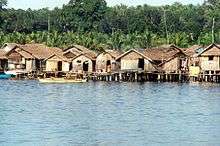
| Population census of BARMM | ||
|---|---|---|
| Year | Pop. | ±% p.a. |
| 1990 | 2,108,061 | — |
| 2000 | 2,803,045 | +2.89% |
| 2010 | 3,256,140 | +1.51% |
| 2015 | 3,781,387 | +2.89% |
| Source: Philippine Statistics Authority[21] [22] | ||
Administrative divisions
The Bangsamoro Autonomous Region in Muslim Mindanao consists of 2 independent cities, 2 component cities, 116 municipalities, and 2,490 barangays.
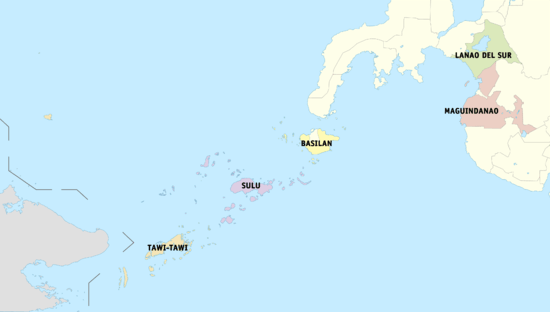
| Province | Capital | Population (2015)[21] | Area[23] | Density | Cities | Muni. | Bgy. | |||||
|---|---|---|---|---|---|---|---|---|---|---|---|---|
| km2 | sq mi | /km2 | /sq mi | |||||||||
| Basilan | Lamitan | 9.2% | 346,579 | 1,103.50 | 426.06 | 310 | 800 | 1 | 11 | 210 | ||
| Lanao del Sur | Marawi | 27.6% | 1,045,429 | 3,872.89 | 1,495.33 | 270 | 700 | 1 | 39 | 1,159 | ||
| Maguindanao | Buluan | 31.0% | 1,173,933 | 4,871.60 | 1,880.94 | 240 | 620 | 0 | 36 | 508 | ||
| Sulu | Jolo | 21.8% | 824,731 | 1,600.40 | 617.92 | 520 | 1,300 | 0 | 19 | 410 | ||
| Tawi-Tawi | Bongao | 10.3% | 390,715 | 1,087.40 | 419.85 | 360 | 930 | 0 | 11 | 203 | ||
| Total | 3,781,387 | 12,535.79 | 4,836.23 | 300 | 780 | 2 | 116 | 2,490 | ||||
Government
BARMM organizational structure
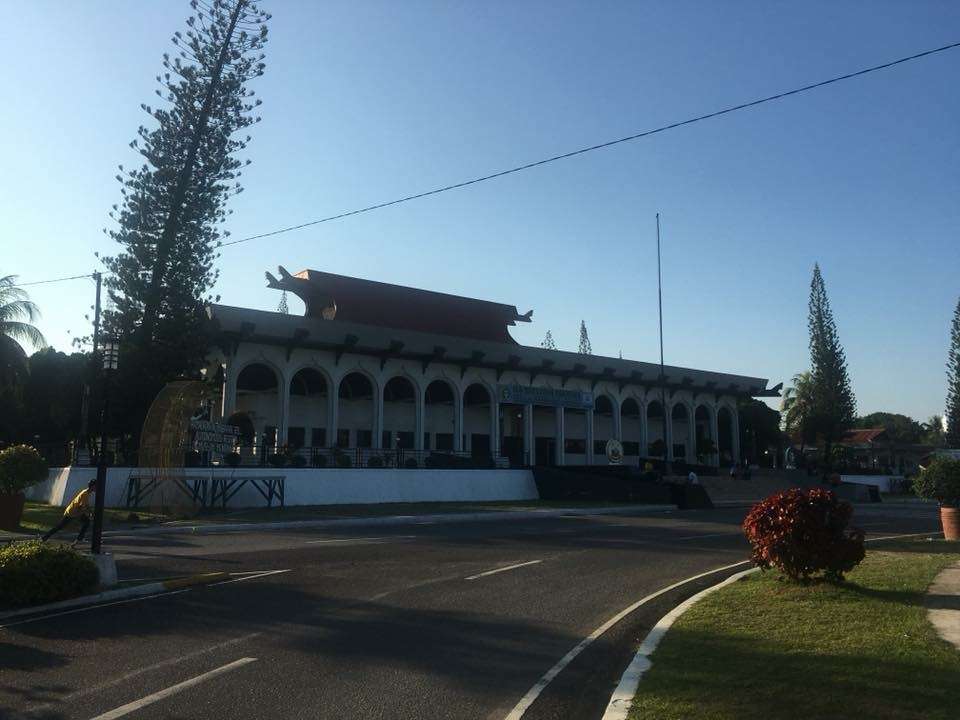
Executive
The region is headed by a Chief Minister of the Bangsamoro. The Chief Minister of the Bangsamoro is elected directly like regular local executives. Regional ordinances are created by the Bangsamoro Parliament, composed of Assemblymen, also elected by direct vote. Regional elections are usually held one year after general elections (national and local) depending on legislation from Congress. Regional officials have a fixed term of three years, which can be extended by an act of Congress.
The Chief Minister of the Bangsamoro is the chief executive of the regional government, and is assisted by a cabinet not exceeding 10 members. He appoints the members of the cabinet, subject to confirmation by the Bangsamoro Parliament. He has control of all the regional executive commissions, agencies, boards, bureaus, and offices.
Bangsamoro Cabinet
The Bangsamoro Cabinet advises the Chief Minister on matters of governance of the autonomous region. It is composed of the chief minister, 1 regional vice governor, and 3 deputy regional governors (each representing the Christians, the Muslims, and the indigenous cultural communities). The chief minister and regional vice governor have a 3-year term, maximum of 3 terms; deputies' terms are coterminous with the term of the regional governor who appointed them.
Legislative
The ARMM has a unicameral Bangsamoro Parliament headed by a Speaker. It is composed of three members for every congressional district. The current membership is 24, where 6 are from Lanao del Sur including Marawi City, 6 from Maguindanao, 6 from Sulu, 3 from Basilan, and 3 from Tawi-Tawi.
The Bangsamoro Parliament is the legislative branch of the BARMM government. The regular members (3 members/district) and sectoral representatives, have three-year terms; maximum of three consecutive terms. It exercises legislative power in the autonomous region, except on the following matters: foreign affairs, national defense and security, postal service, coinage and fiscal and monetary policies, administration of justice, quarantine, customs and tariff, citizenship, naturalization, immigration and deportation, general auditing, national elections, maritime, land, and air transportation, communications, patents, trademarks, trade names, and copyrights, foreign trade, and may legislate on matters covered by the Sharia, the law governing Muslims.
BARMM powers and basic principles
Bangsamoro Organic Law provides that BARMM "shall remain an integral and inseparable part of the national territory of the Republic." The President exercises general supervision over the Regional Governor. The Regional Government has the power to create its own sources of revenues and to levy taxes, fees, and charges, subject to Constitutional provisions and the provisions of No. 11054. The Sharia applies only to Muslims; its applications are limited by pertinent constitutional provisions (prohibition against cruel and unusual punishment).
Economy
GRDP and GVA in Agriculture (2015)
| Item | At Current Prices | At Constant 2000 Prices |
|---|---|---|
| (in million pesos) | ||
| GRDP | 99,576 | 50,583 |
| GVA | 60,343 | 29,440 |
GRDP = Gross Regional Domestic Product
GVA = Gross Value Added in Agriculture, Hunting, Forestry and Fishing
In 2015, the region's economic performance decline by 0.4 percent. It contributed 0.7 percent to the country's Gross Domestic Product. Agriculture, Hunting, Forestry and Fishing sector had 1.5 percent contraction and it shared 58.2 percent in the regional economy.
GRDP Share by Industrial Origin:
Agriculture, Hunting, forestry and fishing - 58.2%
Service - 36.2%
Industry - 5.6%
Production
Production and Area (2015)
| Crop | Production (metric ton) | Area (hectare) |
|---|---|---|
| Palay | 488,215 | 194,349 |
| Corn | 673,036 | 282,295 |
source: countrystat.gov.ph[25]
The region's production of palay at 488,215 metric tons and corn at 673,036 metric tons contracted by 12.37 percent and 3.80 percent, respectively. Area harvested to palay decreased by 10.61 percent. Corn area expanded by 1.69 percent.
Agricultural output in BARMM declined by 1.77 percent in 2015. This was contributed by the production decreases in all subsectors except fisheries. The crops subsector which shared 69.79 percent in agricultural production posted 3.22 percent reduction. The fisheries subsector shared 24.30 percent. Its production grew by 2.57 percent.
Top Agricultural Commodities (2015)
| Commodity | Production Growth Rate | Share to Total Agricultural Output of the Region | Rank of the Region in the National Production |
|---|---|---|---|
| ---------- (in percent) ---------- | |||
| Cassava | (2.01) | 20.03 | 1st |
| Coconut | 2.73 | 13.71 | 4th |
| Corn | (3.8) | 12.77 | 4th |
| Palay | (12.37) | 12.34 | 11th |
| Seaweed | 0.71 | 6.02 | 1st |
Cassava, coconut, corn, palay and seaweed were the top five commodities produced in the region. These commodities contributed 64.87 percent to the region's agricultural output. BARMM ranked 1st in the production of cassava and seaweed.
Employment
Total Employment (CY2015) = 1,259,000 persons
Agricultural Employmen = 874,000 persons
By Sex:
Male = 676,000 persons
Female = 198,000 persons
Daily Agricultural Wage Rate by Sex (2015)
| Sex | Nominal | Real |
|---|---|---|
| (in pesos) | ||
| Male | 253.88 | 162.33 |
| Female | 161.04 | 102.97 |
| Both | 252.70 | 161.57 |
Employed persons in the agriculture sector comprised 69.4 percent of the region's total employment. Majority of the agricultural workers at 77.35 percent were males.
Cultural heritage
The people of the Bangsamoro region, including Muslims and non-Muslims, have a culture that revolves around kulintang music, a specific type of gong music, found among both Muslim and non-Muslim groups of the Southern Philippines. Each ethnic group in BARMM also has their own distinct architectures, intangible heritage, and craft arts. A fine example of a distinct architectural style in the region is the Royal Sulu architecture which was used to make the Daru Jambangan (Palace of Flowers) in Maimbung, Sulu. The palace was destroyed during the American period due to a typhoon in 1932, and was never rebuilt. It used to be the largest royal palace built in the Philippines. A campaign to faithfully re-establish it in Maimbung town has been ongoing since 1933. A very small replica of the palace was made in a nearby town in the 2010s, but it was noted that the replica does not mean that the campaign to reconstruct the palace in Maimbung has stopped as the replica does not manifest the true essence of a Sulu royal palace. In 2013, Maimbung was officially designated as the royal capital of the Sultanate of Sulu by the remaining members of the Sulu royal family.[26][27][28][29]
 Marawi, Lanao del Sur
Marawi, Lanao del Sur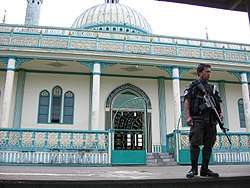
 Grand mosque of Cotabato City
Grand mosque of Cotabato City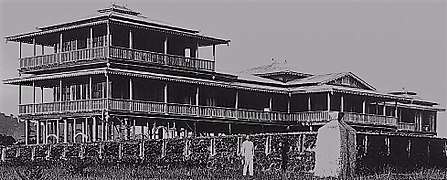
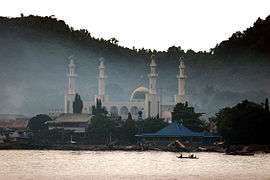
_Hospital_Ship_USNS_Mercy_(T-AH_19)_is_anchored_off_of_the_coast_of_Tawi_Tawi.jpg)
 Pagoda-style mosque in Taraka, Lanao del Sur
Pagoda-style mosque in Taraka, Lanao del Sur
Proposed set-up in a federal government
The Bangsamoro Basic Law bill was considered for shelving by the 17th Congress of the Philippines. The bill was planned to be integrated to the federalism proposal by President Rodrigo Duterte.[30] In case the proposed federalism fails to be passed, President Duterte said that he will concede to the provisions of the bill.[31]
In January 2017, Nene Pimentel proposed in a federalism forum that the Bangsamoro state should be divided into two autonomous regions, namely, mainland Muslim Mindanao and the Sulu archipelago, as the two Muslim areas are distinct from each other in terms of culture. He made the statement after going around the Autonomous Region of Muslim Mindanao, whose people told him that the Muslims of the offshore islands (Basilan, Sulu, Tawi-tawi) do not want to be lumped together with the mainland Muslims of Mindanao as they are distinct from each other. Pimentel also noted that Shariah law could only be applied in the Bangsamoro state (composed of Autonomous Region of Mainland Bangsamoro and Autonomous Region of Sulu) if the two parties are Muslims, but if one or both parties are non-Muslims, national law will always apply. He also stated that the Philippines would include its claim in Sabah under the federal form of government.[32] In January 2018, Pimentel suggested the inclusion of the Malaysian-administered territory of Sabah as a Philippine federal state in itself to assert the Philippine claim over the disputed territory in a way "acceptable under international laws".[33]
Comparisons
| Body | Bangsamoro Autonomous Region | (National Government only) | ||
|---|---|---|---|---|
| Constitutional Document | ARMM Organic Act (Republic Act No. 6734) | Basic Law for the Bangsamoro Autonomous Region[34] | Constitution of the Philippines | |
| Head of State / Territory | Regional Governor of the ARMM | Wāli | President of the Philippines | |
| Head of Government | Chief Minister of the Bangsamoro | |||
| Executive | Executive Departments of the ARMM | Bangsamoro Cabinet | Executive Departments of the Philippines | |
| Legislative | Regional Legislative Assembly | Bangsamoro Parliament | Bicameral: Senate and Congress | |
| Judiciary | None (under Philippine government) | To be determined (Planned) | Supreme Court | |
| Legal Supervisory or Prosecution |
None (under Philippine government) | Planned (before 2016) | Department of Justice | |
| Police Force(s) | Philippine National Police; under the National Government |
Philippine National Police | ||
| Military | Armed Forces of the Philippines (AFP); under the National Government |
Armed Forces of the Philippines (AFP) | ||
| Currency | Philippine peso | Philippine peso | ||
| Official Language(s) | Filipino and English | Filipino and English | ||
| Foreign relations | None | full rights | ||
| Shariah law | Yes, for Muslims only | "Code of Muslim Personal Laws of the Philippines" issued in 1977 under Presidential Directive 1083[35] | ||
See also
References
- ↑ http://thestandard.com.ph/article/206286%5Bpermanent+dead+link%5D
- ↑ "You are being redirected..." www.ptvnews.ph. Retrieved 2018-07-20.
- ↑ Roxas, Pathricia Ann V. "Bicam approves Bangsamoro Organic Law". Retrieved 2018-07-20.
- ↑ "Duterte signs Bangsamoro Organic Law". cnn. Retrieved 2018-07-26.
- ↑ Jennings, Ralph. "Philippine Muslim Autonomy Takes Aim at Years of Strife". VOA. Retrieved 2018-07-28.
- ↑ Esguerra, Anthony Q. "EU expresses support for Bangsamoro Organic Law". Retrieved 2018-07-28.
- ↑ "Gov't, MILF Agree to Create Bangsamoro to Replace ARMM". 15 October 2012. Retrieved 2012-10-15.
- ↑ "'Who is he?' Senate panel to press Iqbal on real name". 10 April 2015. Retrieved 2015-04-10.
- ↑ Framework Agreement of the Bangsamoro. Government of the Philippines. 20 October 2012.
- ↑ "Gov't, MILF seal preliminary peace pact". 15 October 2012. Retrieved 2012-10-15.
- ↑ "Peace Deal Paves The Way For Long And Enduring Peace". 16 October 2012. Retrieved 2012-11-01.
- ↑ "'Malaysia's role should be explained'". The Manila Times. 21 April 2015. Retrieved 23 August 2015.
- ↑ Ellen T. Tordesillas (28 June 2015). "Magdalo Rep: Malaysia's role in creation of Bangsamoro still cause of concern". ABS-CBN News. Retrieved 23 August 2015.
- ↑ "'Philippine govt and MILF requested Malaysia involvement'". The Star. 26 April 2015. Retrieved 23 August 2015.
- ↑ Ted Regencia. "Philippines prepares for historic peace deal". aljazeera.com. Retrieved 23 August 2015.
- ↑ "Philippines, Muslim Rebels Try to Salvage Peace Pact". VOA. Retrieved 23 August 2015.
- 1 2 "Senate sets new timeline for BBL approval". philstar.com. Retrieved 23 August 2015.
- ↑ "Senate BBL debates to start August 17". Sun.Star. Retrieved 23 August 2015.
- ↑ "Senate defers BBL deliberations". cnn. Retrieved 23 August 2015.
- ↑ Rodel Clapano, Jose (4 February 2016). "Congress buries Bangsamoro bill". The Philippine Star. Retrieved 5 February 2017.
- 1 2 Census of Population (2015). Highlights of the Philippine Population 2015 Census of Population. PSA. Retrieved 20 June 2016.
- ↑ "Population and Annual Growth Rates for The Philippines and Its Regions, Provinces, and Highly Urbanized Cities" (PDF). 2010 Census and Housing Population. Philippine Statistics Authority. Archived from the original (PDF) on 28 September 2013. Retrieved 12 August 2013.
- ↑ "Bangsamoro Development Plan Integrative Report, Chapter 10" (PDF). Bangsamoro Development Agency. 2015. Retrieved 2016-05-31.
- ↑ Office of the Bangsamoro People inaugurated | The Manila Times
- ↑ Authority, Philippine Statistics. "Regional Profile: Autonomous Region in Muslim Mindanao (ARMM)". countrystat.psa.gov.ph. Retrieved 2017-12-01.
- ↑ http://newsinfo.inquirer.net/510823/before-his-death-kiram-iii-tells-family-to-continue-fight-to-re-possess-sabah
- ↑ http://www.manilatimes.net/sulu-sultan-dies-from-kidney-failure/219719/
- ↑ https://www.nytimes.com/2015/09/22/world/asia/esmail-kiram-ii-self-proclaimed-sultan-of-sulu-dies-at-75.html
- ↑ https://www.rappler.com/nation/41779-sulu-sultan-jamalul-kiram-iii-dies
- ↑ "No BBL: Next Congress to focus on federalism". Philstar Global.
- ↑ http://www.philstar.com/headlines/2016/07/10/1601334/duterte-concede-bbl-if-federalism-bid-fails
- ↑ https://www.youtube.com/watch?v=fEknUrBAFaM
- ↑ http://www.philstar.com/headlines/2018/01/30/1782857/proposed-federal-govt-set-wants-sabah-included-philippine-territory
- ↑ "DOCUMENT: Marcos submits overhauled Bangsamoro bill". Rappler. Retrieved 23 August 2015.
- ↑ http://www.lawphil.net/statutes/presdecs/pd1977/pd_1083_1977.html
